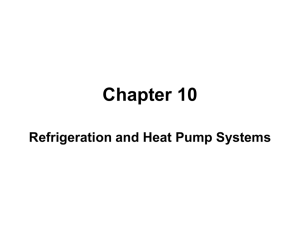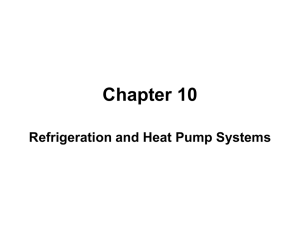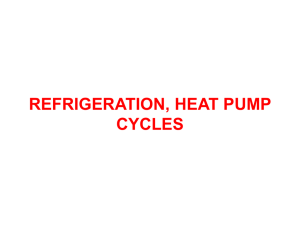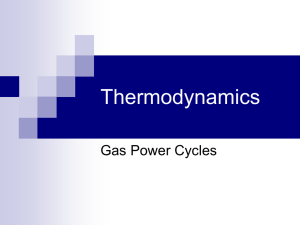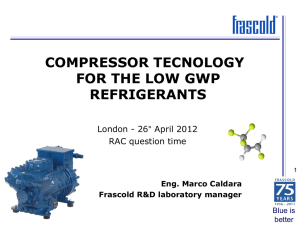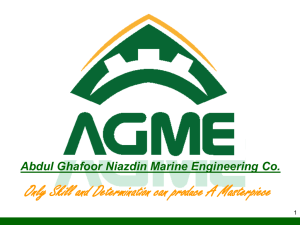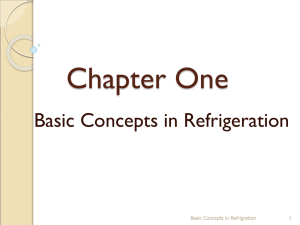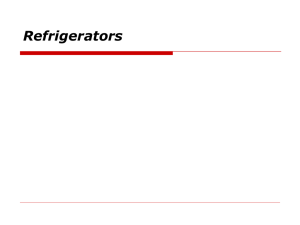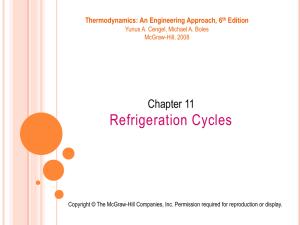Chapter 4
advertisement
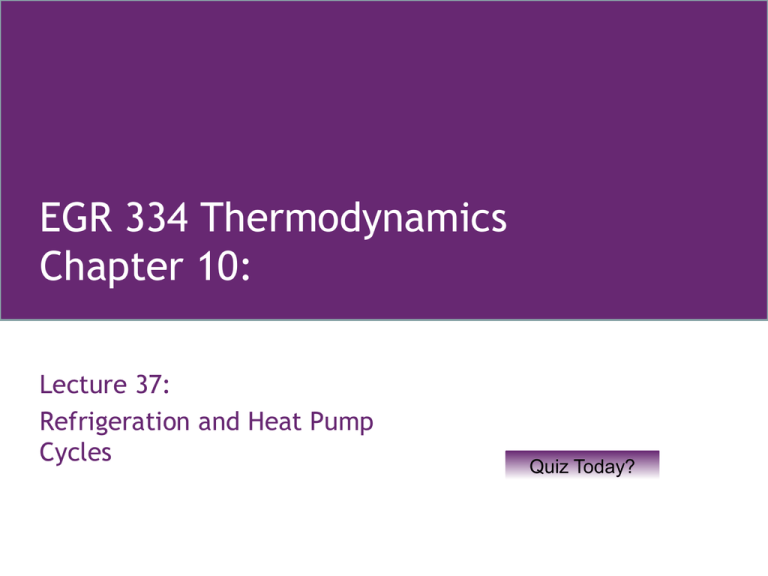
EGR 334 Thermodynamics Chapter 10: Lecture 37: Refrigeration and Heat Pump Cycles Quiz Today? Today’s main concepts: • Be able to explain the working principles of a vaporcompression refrigeration and heat pump systems. • Be able to explain the working principles of a gas refrigeration system. Reading Assignment: Read Chapter 12: Sections 1-4 Homework Assignment: No Assignment How does your refrigerator work? A clear concise explanation: http://www.youtube.com/watch?v=N7XFW O0kOMQ In class discussion: Groups of 3 Refrigeration cycle animation: http://www.ior.org.uk/ior_/fantastic_fridges_site/science/frid ge1/fridgediag.htm Vapor-Compression Refrigeration Cycle • Most common refrigeration cycle in use today • There are four principal control volumes involving these components: • Evaporator • Compressor • Condenser Two-phase • Expansion valve liquid-vapor mixture All energy transfers by work and heat are taken as positive in the directions of the arrows on the schematic and energy balances are written accordingly. The Vapor-Compression Refrigeration Cycle The processes of this cycle are Process 4-1: two-phase liquid-vapor mixture of refrigerant is evaporated through heat transfer from the refrigerated space. Process 1-2: vapor refrigerant is compressed to a relatively high temperature and pressure requiring work input. Two-phase liquid-vapor mixture Process 2-3: vapor refrigerant condenses to liquid through heat transfer to the cooler surroundings. Process 3-4: liquid refrigerant expands to the evaporator pressure. The Vapor-Compression Refrigeration Cycle Engineering model: • Each component is analyzed as a control volume at steady state. • Dry compression is presumed: the refrigerant is a vapor. • The compressor operates adiabatically. • The refrigerant expanding through the valve undergoes a throttling process. • Kinetic and potential energy changes are ignored. The Vapor-Compression Refrigeration Cycle Applying mass and energy rate balances Evaporator Q in m h1 h 4 (Eq. 10.3) • The term Q in is referred to as the refrigeration capacity, expressed in kW in the SI unit system or Btu/h in the English unit system. • A common alternate unit is the ton of refrigeration which equals 200 Btu/min or about 211 kJ/min. The Vapor-Compression Refrigeration Cycle • Applying mass and energy rate balances Compressor Assuming adiabatic compression Condenser W c m Q out m Expansion valve Assuming a throttling process h 2 h1 (Eq. 10.4) h 2 h3 (Eq. 10.5) h 4 h3 (Eq. 10.6) The Vapor-Compression Refrigeration Cycle ►Performance parameters Coefficient of Performance (COP) (Eq. 10.7) Carnot Coefficient of Performance (Eq. 10.1) This equation represents the maximum theoretical coefficient of performance of any refrigeration cycle operating between cold and hot regions at TC and TH, respectively. Features of Actual Vapor-Compression Cycle Heat transfers between refrigerant and cold and warm regions are not reversible. • Refrigerant temperature in evaporator is less than TC. • Refrigerant temperature in condenser is greater than TH. • Irreversible heat transfers have negative effect on performance. Features of Actual Vapor-Compression Cycle The COP decreases – primarily due to increasing compressor work input – as the • temperature of the Trefrigerant ↑ refrigerant passing through the evaporator is reduced relative to the temperature of the cold region, TC. • temperature of the Trefrigerant ↓ refrigerant passing through the condenser is increased relative to the temperature of the warm region, TH. Features of Actual Vapor-Compression Cycle Irreversibilities during the compression process are suggested by dashed line from state 1 to state 2. • An increase in specific entropy accompanies an adiabatic irreversible compression process. The work input for compression process 1-2 is greater than for the counterpart isentropic compression process 1-2s. • Since process 4-1, and thus the refrigeration capacity, is the same for cycles 1-2-3-4-1 and 1-2s-3-4-1, cycle 1-2-3-4-1 has the lower COP. Isentropic Compressor Efficiency The isentropic compressor efficiency is the ratio of the minimum theoretical work input to the actual work input, each per unit of mass flowing: work required in an isentropic compression from compressor inlet state to the exit pressure (Eq. 6.48) work required in an actual compression from compressor inlet state to exit pressure Actual Vapor-Compression Cycle Example: The table provides steady-state operating data for a vapor-compression refrigeration cycle using R-134a as the working fluid. For a refrigerant mass flow rate of 0.08 kg/s, determine the (a) compressor power, in kW, (b) refrigeration capacity, in tons, (c) coefficient of performance, (d) isentropic compressor efficiency. State 1 2s 2 3 4 h (kJ/kg) 241.35 272.39 280.15 91.49 91.49 Actual Vapor-Compression Cycle State 1 2s 2 3 4 h (kJ/kg) 241.35 272.39 280.15 91.49 91.49 (a) The compressor power is W c m ( h 2 h1 ) kg kJ 1 kW W c 0 . 08 3.1 kW ( 280 . 15 241 . 35 ) s kg 1 kJ/s (b) The refrigeration capacity is Q in m ( h1 h 4 ) kg kJ 1 ton Q in 0 . 08 ( 241 . 35 91 . 49 ) s kg 211 kJ/min 60 s min 3.41 tons Actual Vapor-Compression Cycle State 1 2s 2 3 4 h (kJ/kg) 241.35 272.39 280.15 91.49 91.49 (c) The coefficient of performance is ( h1 h 4 ) ( h 2 h1 ) ( 241 . 35 91 . 49 ) kJ/kg ( 280 . 15 241 . 35 ) kJ/kg 3.86 Actual Vapor-Compression Cycle State 1 2s 2 3 4 h (kJ/kg) 241.35 272.39 280.15 91.49 91.49 (d) The isentropic compressor efficiency is c c W c / m s W c / m ( h 2 s h1 ) ( h 2 h1 ) ( 272 . 39 241 . 35 ) kJ/kg ( 280 . 15 241 . 35 ) kJ/kg 0.8 = 80% p-h Diagram ►The pressure-enthalpy (p-h) diagram is a thermodynamic property diagram commonly used in the refrigeration field. Selecting Refrigerants Refrigerant selection is based on several factors: • Performance: provides adequate cooling capacity cost-effectively. • Safety: avoids hazards (i.e., toxicity). • Environmental impact: minimizes harm to stratospheric ozone layer and reduces negative impact to global climate change. Refrigerant Types and Characteristics Global Warming Potential (GWP) is a simplified index that estimates the potential future influence on global warming associated with different gases when released to the atmosphere. Refrigerant Types and Characteristics • Chlorofluorocarbons (CFCs) and Hydrochlorofluorocarbons (HCFCs) are early synthetic refrigerants each containing chlorine. Because of the adverse effect of chlorine on Earth’s stratospheric ozone layer, use of these refrigerants is regulated by international agreement. • Hydrofluorocarbons (HFCs) and HFC blends are chlorinefree refrigerants. Blends combine two or more HFCs. While these chlorine-free refrigerants do not contribute to ozone depletion, with the exception of R-1234yf, they have high GWP levels. • Natural refrigerants are nonsynthetic, naturally occurring substances which serve as refrigerants. These include carbon dioxide, ammonia, and hydrocarbons. These refrigerants feature low GWP values; still, concerns have been raised over the toxicity of NH3 and the safety of the hydrocarbons. Vapor-Compression Heat Pump Systems • The objective of the heat pump is to maintain the temperature of a space or industrial process above the temperature of the surroundings. • Principal control volumes involve these components: • • • • Evaporator Compressor Condenser Expansion valve The Vapor-Compression Heat Pump Cycle Performance parameters Coefficient of Performance (Eq. 10.10) Carnot Coefficient of Performance (Eq. 10.9) This equation represents the maximum theoretical coefficient of performance of any heat pump cycle operating between cold and hot regions at TC and TH, respectively. Vapor-Compression Heat Pump System The method of analysis for vapor-compression heat pumps closely parallels that for vapor-compression refrigeration systems. Example: A vapor-compression heat pump cycle with R134a as the working fluid maintains a building at 20oC when the outside temperature is 5oC. The refrigerant mass flow rate is 0.086 kg/s. Additional steady state operating data are provided in the table. Determine the (a) compressor power, in kW, (b) heat transfer rate provided to the building, in kW, (c) coefficient of performance. State h (kJ/kg) 1 2 3 244.1 272.0 93.4 TH = 293 K (20oC) TC = 278 K (5oC) Vapor-Compression Heat Pump System State h (kJ/kg) 1 2 3 244.1 272.0 93.4 TH = 293 K (20oC) (a) The compressor power is W c m ( h 2 h1 ) kg kJ 1 kW W c 0 . 086 2.4 kW ( 272 . 0 244 . 1) s kg 1 kJ/s (b) The heat transfer rate provided to the building is Q out m ( h 2 h 3 ) kg kJ 1 kW Q out 0 . 086 ( 272 . 0 93 . 4 ) s kg 1 kJ/s 15.4 kW TC = 278 K (5oC) Vapor-Compression Heat Pump System State h (kJ/kg) 1 2 3 244.1 272.0 93.4 TH = 293 K (20oC) TC = 278 K (5oC) (c) The coefficient of performance is Q out W 1 5.4 kW 2 .4 kW c 6.4 Comment: Applying Eq. 10.9, the maximum theoretical coefficient of performance of any heat pump cycle operating between cold and hot regions at TC and TH, respectively is max TH T H TC max 2 93 K 2 93 K 2 7 8 K 19.5 Brayton Refrigeration Cycle • The working fluids of vapor-compression systems undergo liquid-to-vapor phase change. In Brayton refrigeration systems the working fluid remains a gas throughout. • The Brayton refrigeration cycle is the reverse of the Brayton power cycle introduced in Sec. 9.6 as shown in the figure. Brayton Refrigeration Cycle ►The processes of this cycle are Process 1-2: the refrigerant gas, which may be air, enters the compressor at state 1 and is compressed to state 2. Process 2-3: The gas is cooled by heat transfer to the warm region at temperature TH. Process 3-4: The gas expands through the turbine to state 4, where the temperature, T4, is well below TC. Process 4-1: Refrigeration of the cold region is achieved through heat transfer from the cold region to the gas as it passes from state 4 to state 1, completing the cycle. The work developed by the turbine assists in driving the compressor. Brayton Refrigeration Cycle The coefficient of performance of the cycle is (Eq. 10.11) End of slides for Lecture 37

